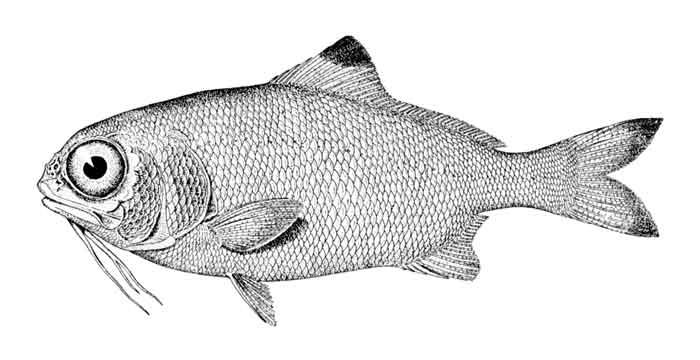Superregnum: Eukaryota
Cladus: Unikonta
Cladus: Opisthokonta
Cladus: Holozoa
Regnum: Animalia
Subregnum: Eumetazoa
Cladus: Bilateria
Cladus: Nephrozoa
Superphylum: Deuterostomia
Phylum: Chordata
Subphylum: Vertebrata
Infraphylum: Gnathostomata
Megaclassis: Osteichthyes
Superclassis/Classis: Actinopterygii
Classis/Subclassis: Actinopteri
Subclassis/Infraclassis: Neopterygii
Infraclassis: Teleostei
Megacohors: Osteoglossocephalai
Supercohors: Clupeocephala
Cohors: Euteleosteomorpha
Subcohors: Neoteleostei
Infracohors: Eurypterygia
Sectio: Ctenosquamata
Subsectio: Acanthomorphata
Divisio: Polymixiipterygii
Superordo: Polymixiomorpha
Ordo: Polymixiiformes
Familia: Polymixiidae
Genus: Polymixia
Species: P. berndti – P. busakhini – P. fusca – P. japonica – P. longispina – P. lowei – P. nobilis – P. salagomeziensis – P. sazonovi – P. yuri
Name
Polymixia Lowe, 1838
Synonyms
Dinemus Poey, 1860
Gender
feminine
References
Lowe, R. T. (1838) Piscium Maderensium species quaedam novae, vel minus rite cognitae breviter descriptae, etc. Transactions of the Cambridge Philosophical Society v. 6: 195–202, 5 col. pls.
Polymixia – Taxon details on Integrated Taxonomic Information System (ITIS).
Vernacular names
Türkçe: Sakallı balık

Polymixia nobilis
Polymixia is the only extant genus of the order Polymixiiformes and family Polymixiidae. It contains 10 species, all of which live in deepwater marine environments.[1] They are found in tropical and subtropical waters of the Atlantic, Indian and western Pacific Oceans. They are bottom-dwelling fish, found down to about 800 m (2,600 ft). Most are relatively small fish, although one species is over 40 cm (16 in) in length.[2] They can be considered "living fossils" due to being the only surviving members of the once-diverse order Polymixiiformes.[3]
Classification
There are currently 12 recognized species in this genus:[1]
Polymixia berndti C. H. Gilbert, 1905 (Pacific beardfish)
Polymixia busakhini Kotlyar, 1993 (Busakhin's beardfish)
Polymixia carmenae Caixeta, Oliveira & de Melo, 2024 (Brazilian beardfish)[4]
Polymixia fusca Kotthaus, 1970
Polymixia hollisterae Grande & Wilson, 2021 (Bermuda beardfish)[5]
Polymixia japonica Günther, 1877 (Silver eye)
Polymixia longispina S. M. Deng, G. Q. Xiong & H. X. Zhan, 1983
Polymixia lowei Günther, 1859 (Beardfish)
Polymixia nobilis R. T. Lowe, 1838 (Stout beardfish)
Polymixia salagomeziensis Kotlyar, 1991
Polymixia sazonovi Kotlyar, 1992
Polymixia yuri Kotlyar, 1982
The extinct species Polymixia polita Schwarzhans, 2012 is known from fossil otoliths from the early and late Paleocene of Germany and Austria.[6] Another otolith-based taxon that may possibly belong to this genus, Polymixia? harderi (Schwarzhans, 2003) is known from the late Maastrichtian and early Paleocene of Denmark, in addition to a potential earlier record from the Campanian of North Carolina, USA; this may suggest Late Cretaceous origins for the genus.[7][8]
References
Froese, Rainer and Pauly, Daniel, eds. (2017). Species of Polymixia in FishBase. February 2017 version.
Paxton, John R. (1998). Paxton, J.R.; Eschmeyer, W.N. (eds.). Encyclopedia of Fishes. San Diego: Academic Press. p. 161. ISBN 0-12-547665-5.
De Cia Caixeta, Heloísa; Oliveira, Claudio; Melo, Marcelo Roberto Souto de (2024-03-01). "Another piece of the living fossil puzzle: A new species of Polymixia Lowe, 1836 (Polymixiiformes: Polymixiidae) from the western South Atlantic". Deep Sea Research Part I: Oceanographic Research Papers. 205: 104249. doi:10.1016/j.dsr.2024.104249. ISSN 0967-0637.
De Cia Caixeta, Heloísa; Oliveira, Claudio; Melo, Marcelo Roberto Souto de (2024-03-01). "Another piece of the living fossil puzzle: A new species of Polymixia Lowe, 1836 (Polymixiiformes: Polymixiidae) from the western South Atlantic". Deep Sea Research Part I: Oceanographic Research Papers. 205: 104249. doi:10.1016/j.dsr.2024.104249. ISSN 0967-0637.
Grande, Terry C.; Wilson, Mark V. H. (2021-07-16). "A New Cryptic Species of Polymixia (Teleostei, Acanthomorpha, Polymixiiformes, Polymixiidae) Revealed by Molecules and Morphology". Ichthyology & Herpetology. 109 (2). doi:10.1643/i2020112. ISSN 2766-1512.
Schwarzhans, Werner (2012). "Fish otoliths from the Paleocene of Bavaria (Kressenberg) and Austria (Kroisbach and Oiching-Graben) / / Werner Schwarzhans". Palaeo Ichthyologica. 12: 1–88.
"Bulletin Volume 65 – 2017". Dansk Geologisk Forening (in Danish). 2017-02-15. doi:10.37570/bgsd-2017-65-05. Retrieved 2024-07-28.
Stringer, Gary L.; Clements, Don; Sadorf, Eric; Shannon, Kevin (2019). "First Description and Significance of Cretaceous Teleostean Otoliths (Tar Heel Formation, Campanian) from North Carolina". Eastern Paleontologist. 4: 1–22. ISSN 2475-5117.
Retrieved from "http://en.wikipedia.org/"
All text is available under the terms of the GNU Free Documentation License

